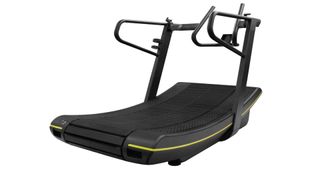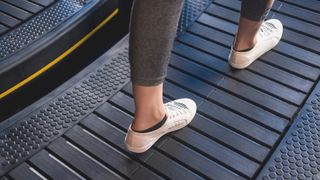If you’ve seen a curved treadmill at the gym and wondered what it’s for, you’re not alone. Despite the odd design, it turns out this curved device has the potential to elevate your runs, but which treadmill burns the most calories?
When you hit one of the best treadmills for indoor running and walking workouts, it seems like the features are becoming exhaustive – inclines, dips, parachute mode, and sled push are just a few of the ways treadmills make your workout even more challenging. .
The curved treadmill is one of the latest in treadmill evolution, with a non-motorized belt that may leave some users unsure how to use it. Below, we cover everything you need to know about curved vs. flat treadmills, and why using one might burn more calories and push your runs to new heights.
What is a curved treadmill?
The curved treadmill’s unique arc shape supposedly mimics a more natural stride during runs and walks. The gentle curve of the belt rises front and back, allowing your foot strike to pull the treadmill down and back so your body weight can drive the motion without a motor.
Yes, you’re doing all the hard work, which requires more energy and muscle strength than running or walking on a flat motorized treadmill. In theory, you can push yourself as you please, but building momentum for sustained periods takes some work.
And many popular treadmill brands are jumping on the bandwagon, including Technogym and AirRunner. But are they worth the money or just another fitness fad?
Curved treadmill vs flat treadmill: pros and cons
Before you settle on one over the other, there are a few health pros and cons to using a curved tread on a standard flat treadmill.
Impact
First, curved treadmills were designed to encourage a more natural gait, running towards your toes rather than driving with a heel strike; this placement could reduce the strain on the joints that comes with pounding vertically on a flat surface, and more closely mimics outdoor terrain.
The arch might also help activate the posterior chain muscles, including the glutes, hamstrings, and calf muscles in the back of the body, which many flat-surface runners struggle to activate properly.
Rhythm
The closer you get to the top of the turn, the faster you’ll be able to ride the tape by pushing down and pulling back with your foot, allowing you to set the pace. This has also been found to be useful for monitoring self-stimulation (opens in a new tab) and fatigue in athletes during testing, as there’s nowhere to hide when you’re leading the movement.
Curved treadmills don’t have a minimum or maximum pace, which is entirely set by you, meaning anyone can use one without worrying if there are enough speed options available.
That said, for anyone who enjoys a walking workout, the best under-desk treadmills are great for consistency and leisurely strolls if you plan to work up the steps while your mind is occupied elsewhere.
Muscle activation
We know that whether you’re running on a treadmill or running outdoors, this form of exercise activates various major muscle groups, strengthens joints and bones, and builds aerobic and anaerobic endurance.
Running on a curved treadmill requires your core and lower body muscles to work together to produce enough energy to move the belt, and some create more friction than others. Either way, core muscles, lower back, arms, hip flexors, glutes, quads, hamstrings AND the calves are working hard to move the belt under you, which is more metabolically demanding.
Despite this, many users prefer to run on treadmills on the floor or on level ground to achieve a more consistent pace without losing momentum or thinking about what their body is doing.
A study (opens in a new tab) examined the effects of the lean curve on your muscles and its impact on the forward lean position of your body. Interestingly, the results showed greater hamstring and decreased quadriceps activation during motorized treadmill exercise and vice versa during non-motorized treadmill exercise.
While logic suggests that greater traction on each step would activate the hamstrings more, the researchers concluded that the findings could be due to the canted curve, which requires greater hip flexion as the foot strikes and greater hip extension. hip during toe.
Curved Treadmill vs Flat Treadmill: Which Burns More Calories?
With the high-intensity nature of the movement, curved treadmills are thought to burn more calories than flat treadmills and provide a harder, more efficient workout in less time. But what does the research say?
A study published by ProQuest (opens in a new tab) says manufacturers believe that exercising on a curved treadmill could burn 30 percent more calories than flat motorized treadmills. The researchers in this study found an increase in aerobic capacity and caloric expenditure in female athletes who performed curved tread runs compared to motorized ones.
Another study conducted at Eastern Washington University (opens in a new tab) participants tested by walking for 10 minutes at 3 miles per hour on a curved, motorized treadmill. The results found a significant increase in calorie burn and RPE (rate of perceived exertion) for those who walk curved steps compared to those who don’t.
And research (opens in a new tab) on male runners found that curved treadmills elicited higher heart rates, VO2 max (oxygen uptake during exercise), RPE, and cadence rate. He concluded that curved treadmill running required more physiologically and perceptually, but this also showed less efficient running economy.
Curved treadmill vs flat treadmill: verdict
Current research indicates that curved tread workouts may be more physically demanding and offer potentially higher calorie burn. However, most of the existing research out there is somewhat limited, both when testing and reporting results.
And while there is support for curved treadmills on flat and motorized versions, biomechanically and athletically speaking, there isn’t enough conclusive evidence to say either way.
That said, it depends on what you use your treadmill for. Economically, curved treadmills don’t require electricity to operate and could provide a more natural feel and high-intensity workout in a shorter period.
But without a motor, while you can start sprint intervals immediately, you’ll struggle to accelerate, so reaching initial power is difficult (despite no top speed). Friction will help you work on consistency, but if your goal involves sprint starts and acceleration, rehabilitation or flat runs, you may prefer outdoor or motorized training.
Either way, any treadmill is good for improving conditioning, which is suitable for most athletes or runners working on their cardiovascular fitness.
More from Tom’s Guide
#Curved #Treadmills #Flat #Treadmills #Burns #Calories



